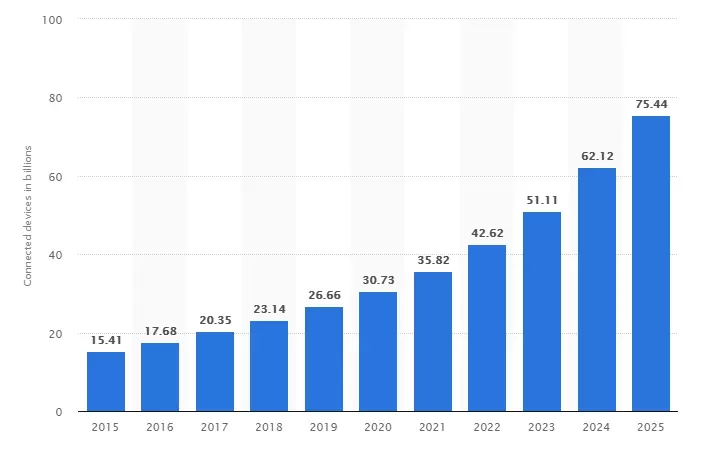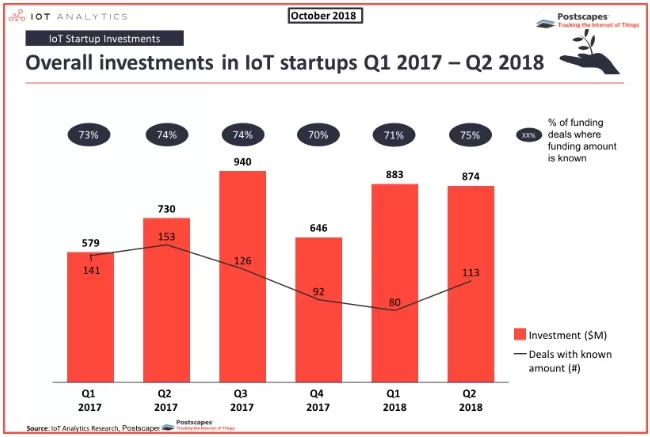The current year is drawing to a close, so it’s the right time to discuss the market trends which have defined the IoT domain in 2018. According to Statista, the number of devices with access to the Internet will increase to 23 billion by the end of the year. The overall Internet of Things market is projected to be worth more than one billion U.S. dollars annually from 2017 onwards.

Once again, these figures confirm that IoT technologies remain one of the significant factors changing the rules of the game. In 2017, hundreds of startups presented solutions with the purpose to bring the revolution in IoT domain a bit closer. No wonder that new companies implementing bold (and, what’s more important, useful) innovations tend to receive investments. According to IoT Analytics’ report, there are currently about 100 recorded IoT funding rounds per quarter. In Q2/2018 the volume of total recorded IoT investments hit $874M.

In the era of in the fourth industrial revolution, both governmental and business organizations are eager to support the introduction of breakthrough innovations. This way, leading providers of software platforms for the Internet of Things have strengthened their positions while paving the way for integrating IoT technologies between various industries.
Some industry analysts predict that the IoT infrastructure and specialized IoT platforms will evolve at a faster pace than they do now, and security will remain a key problem. In a nutshell, the year 2018 will be remembered by various events worth your attention.
Mass Expansion of IoT Platforms
According to the Forrester Wave’s report, 60% of industry professionals are already using or planning to use IoT-enabled applications for the next two years. The range of application solutions is quite wide: from designing connected products to transforming operating processes.
At the moment, however, we’ve found ourselves “at the dawn” of IoT introduction. This way, the shift towards regulating and standardizing new technologies and protocols often resembles a sort of “blindfold” movement. The report indicates that, as of today, industry professionals have to deal with “fragmented sets of hardware, protocols, software, applications, and analytic solutions”. Naturally, these problems get in the way in the process of IoT implementation.
Problems or not, they can’t totally stop the progress. For now, professional IoT platforms from IBM, Cisco, General Electric or Amazon can be regarded as multi-tier solutions that facilitate the design and management of IoT infrastructure and enterprise data. These multifunctional products will solve the remaining problems and help companies and governments create, protect, connect and manage IoT devices on a large scale.
And this is the perfects illustration of how the high level of competition between vendors may be profitable for all sides as it leads to the improvement of solutions they develop.
For example, AWS IoT offers the technology to launch trained machine learning models on peripheral devices, and IBM’s Watson IoT platform shows extensive analytic capabilities. Meanwhile, Microsoft Azure IoT Suite launches convenient and straightforward functionality for the integration of connected devices into the corporate infrastructure.
So, it would be fair to conclude that next year, the further development of IoT platforms and the large-scale implementation of ready-made applications for machine management, security, predictive maintenance, and asset analysis will continue.
Synergy: Artificial intelligence, Augmented Reality and Machine Learning
Virtually no technology develops on its own, and the same rule applies to the IoT sector. A wide range of IoT applications includes multiple integrations with machine learning capabilities, pattern recognition, augmented reality (AR), the blockchain, and other technologies.
Those projects are omnipresent. For instance, IOTA blockchain cooperates with large IoT players to ensure the protection of micropayment transactions processed between smart devices autonomously. The Zappar AR platform, in partnership with Ervythng, develops solutions for improved interactivity of smart devices.
The concept of predictive service is one of the most promising IoT applications both in industrial and consumer markets. The idea stands on the integration of machine learning into the IoT infrastructure. With the help of machine learning, the repository of both real-time data and historical data is transformed into analytical pictures and predictive models so that they can foresee the physical wear of machinery mechanisms, automate maintenance, prevent failures and, obviously, reduce costs.
Technology improvements will occur both through mergers and acquisitions – as in the case of the PTC IoT ThingWorx platform and the AR SDK Vuforia. Or in-house as well: see the case of the joint efforts of IBM Watson Natural Language Understanding, Watson Machine Learning and IBM IoT Watson Platform.
Dealing with Data
As many industry professionals refrain: “Data is the basis for IoT”. But only well-prepared, “cleaned”, formatted and indexed data may turn into valuable ideas. It is believed that 80% of the actions associated with obtaining analytical information from heterogeneous data represent extremely dull work. As a result, not each and every company implementing IoT is able to benefit from using this information.
In this regard, the emergence of a variety of approaches to data analysis, their application and monetization is expected. Back in 2017, IOTA initiated the creation of a data trading platform, where any connected device or sensor could acquire valuable data through microtransactions. This initiative is supported by Cisco, Orange, Accenture, Deutsche Telekom, Daimler, Schneider Electric, EWE, Tine, PwC, DNV GL and other major players. “The data marketplace will be the catalyst for a new paradigm of research, AI, and the democratization of data,” said IOTA co-founder David Sønstebø.
New Approaches to Security
Security and personal data loss remain the most significant issues in the entire IoT ecosystem. According to Forbes, 60% of consumers are concerned about the vulnerabilities of connected devices, and 62% consider confidentiality the main problem. Moreover, 92% of IoT developers think that security will be a problem to tackle in the future.
The security issue is a matter of concern at different levels: from the transfer of enterprise data, the exchange of personal data and transaction security to ensuring the reliability of equipment and devices, and to the integrity of the IoT system.
Today, biometric identification of personal mobile devices has already become the standard for ensuring privacy. Soon, the connected devices will take advantage of the extended authentication. For instance, Amazon Alexa promises to teach voice recognition for up to ten people before performing any important user commands.
The fears of confidentiality is another problem that equipment manufacturers and service providers need to overcome. LockState solves this problem by describing its authentication technology in IoT as “encryption at the bank level”. This method ensures that the use of the data is secure as if one uses encryption keys. However, at the moment, LockState uses this approach only in its own equipment.
The problem of ensuring confidentiality in the scale of connected houses and related cities also needs to be addressed. In 2018, the biggest challenge is still the security of Big Data in IoT ecosystems. Sure enough, the application of this data can change the situation and help in solving global environmental, political, economic and medical problems. But on the other hand, data manipulation may put into jeopardy the security of industries, economies and even countries.
By 2030, IoT will add up to $15 trillion to the growth of global GDP, according to analysts General Electric. The volume of the IoT technology market will grow by 200% annually and transform the industry, business operations and even the traditional transport industry.









